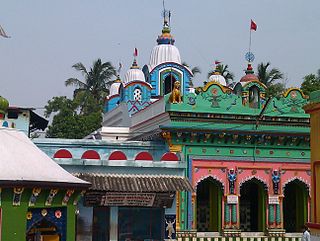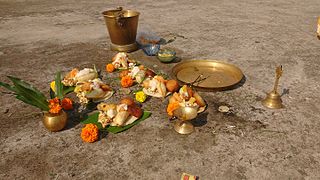
Jagannatha is a deity worshipped in regional Hindu traditions in India as part of a triad along with his (Krishna's) brother Balabhadra, and sister, Subhadra. Jagannath, within Odia Hinduism, is the supreme god, Purushottama, and the Para Brahman. To most Vaishnava Hindus, particularly the Krishnaites, Jagannath is a form of Krishna, sometimes as the avatar of Vishnu.
Konark is a medium town in the Puri district in the state of Odisha, India. It lies on the coast by the Bay of Bengal, 65 kilometres from the capital of the state, Bhubaneswar. It is the site of the 13th-century Sun Temple, also known as the Black Pagoda, built in black granite during the reign of Narasinghadeva-I. The temple is a World Heritage Site. The temple is now mostly in ruins, and a collection of its sculptures is housed in the Sun Temple Museum, which is run by the Archaeological Survey of India.

Puri district is a coastal district of the Odisha state of India. It has one sub-division, 11 tahasils and 11 blocks and comprises 1722 revenue villages. Puri is the only municipality of the district. Konark, Pipili, Satyabadi, Gop, Kakatpur and Nimapada are the NACs in this district while Brahmagiri being a semi-urban town.

The history of Odisha begins in the Lower Paleolithic era, as Acheulian tools dating to the period have been discovered in various places in the region. The early history of Odisha can be traced back to writings found in ancient texts like the Mahabharata, Maha Govinda Sutta and some Puranas. The region was also known to other kingdoms in region of East Indies due to maritime trade relations.

Anangabhima Deva III was an Eastern Ganga monarch who ruled an early medieval Odisha-centered empire in eastern India from the year 1211 to 1238 CE. He maintained a large territory that stretched from the river Ganga in the north to Godavari in the south. He had defeated the Kalachuris on the western frontiers of the empire and established a matrimonial alliance with them. His brother or brother-in-law, Rajaraja II, became the ruler of the dynasty in 1198. When Anangabhima III came into power in 1211, he expelled the Muslims of Bengal from his kingdom. He had a son, Narasingha Deva I, who invaded Bengal in 1244 and captured the capital city, Gauda. He was a reformist in the social and spiritual structure of the Odia society as the vaishnavite deity Jagannath was declared as the supreme ruler of the empire and the emperor as the deputy under him. The Madala Panji records he claiming himself as Shri Purushottama dedicating everything to lord Jagannath. He built the famous Pradaskhina mandapa of Srikurmam temple.
The Gajapati Empire, was an empire established by the Suryavamsa dynasty or Routray dynasty, who were a medieval Hindu dynasty in the Indian subcontinent. It originated in the region of Trikalinga and reigned from 1434 to 1541 CE. It succeeded the reign of the Eastern Gangas. Under the Emperor Kapilendra Deva, the Gajapati empire stretched from lower Ganga in the north to Kaveri in the south.

Konark Sun Temple is a 13th-century CE Hindu Sun temple at Konark about 35 kilometres (22 mi) northeast from Puri city on the coastline in Puri district, Odisha, India. The temple is attributed to king Narasingha Deva I of the Eastern Ganga dynasty about 1250 CE.
Western Odisha is the western part of the state of Odisha in India, extending from the Kalahandi district in the south to the Sundargarh district in the north.

The Eastern Ganga dynasty were a large medieval era Indian royal Hindu dynasty that reigned from Kalinga from as early as the 5th century to the mid 20th century. Eastern Gangas ruled much of the modern region of Odisha in three different phases by the passage of time, known as Early Eastern Gangas (493–1077), Imperial Eastern Gangas (1077–1436) and Khemundi Gangas (1436–1947). They are known as "Eastern Gangas" to distinguish them from the Western Gangas who ruled over Karnataka. The territory ruled by the dynasty consisted of the whole of the modern-day Indian state of Odisha, as well as major parts of north Andhra Pradesh, parts of Chhattisgarh and some southern districts of West Bengal. Odia language got official status in their regime following the evolution of the language from Odra Prakrit. The early rulers of the dynasty ruled from Dantapuram; the capital was later moved to Kalinganagara, and ultimately to Kataka and then to Paralakhemundi.

Gajapati Langula Narasingha Deva I was an Eastern Ganga monarch and a warrior of the Kalinga region who reigned from 1238 CE to 1264 CE. He defeated the Muslim forces of Bengal who constantly threatened the Eastern Ganga dynasty's rule over his kingdom of Kalinga from the times of his father Anangabhima Deva III. He was the first king from Kalinga and one of the few rulers in India who took the offensive against the Islamic expansion over India by Turko-Afghan invaders of Eastern India. His father had successfully defended his kingdom against the Turko-Afghan rulers of Bengal and crossed into Rarh, Gauda and Varendra in Bengal chasing the invaders on backfoot. He became the dominant ruler of the peninsula by defeating the Turko-Afgan, Gouda, and the powerful monarch of the south kakatiya Dynasty king Ganapati Deva, and was one of the most powerful Hindu rulers in India. He also built the Konark temple to commemorate his victories over the Muslims as well as other temples and the largest fort complex of Eastern India at Raibania in Balasore. He also built famous Varaha Lakshmi Narasimha Temple at Simhachalam, Andhra Pradesh. The Kendupatana plates of his grandson Narasingha Deva II mention that Sitadevi, the queen of Narasingha Deva I was the daughter of the Paramara king of Malwa.

'Suramani' PanditRaghunath Panigrahi was an Odissi music Guru, vocalist, composer and music director. He is most known for his renditions of Jayadeva's Gita Govinda and his vocal support for his wife, the Odissi danseuse Sanjukta Panigrahi. Raghunath belonged to a family associated with Odissi music for centuries, members of which were 19th-century Odissi poet-composer Sadhaka Kabi Gourahari Parichha and Gayaka Siromani Apanna Panigrahi who was the royal musician (raja-sangitagya) of Paralakhemundi. He started his musical training from his father Pt Neelamani Panigrahi, who had been collecting traditional Odissi melodies of the Gita Govinda from the Jagannatha Temple of Puri. Later, Raghunath continued learning Odissi music under Pt Narasingha Nandasarma and Pt Biswanatha Das. He was widely known as 'Gitagobinda Panigrahi'.

Kshirachora Gopinatha Temple is a Hindu temple in Remuna, Odisha, India. The name "Remuna" is from the word "Ramaniya" which means very good-looking. "Kshirachora" in Odia means Stealer of condensed Milk and Gopinatha means the Divine Consort of Gopis. The reference is to child Krishna's love for milk and milk products. It is Classified one among the 108 Abhimana Kshethram of Vaishnavate tradition.

Samba Dashami is a festival unique to the state of Odisha, India. It is celebrated on the 10th day of the Shukla Paksha of Pausha Māsa or waxing phase of moon in the month of Pausha as per traditional Odia calendar. This festival is especially celebrated in the eastern part of Odisha.

The Kaḷinga architectural style is a style of Hindu architecture which flourished in the ancient Kalinga previously known as Utkal and in present eastern Indian state of Odisha. The style consists of three distinct types of temples: Rekha Deula, Pidha Deula and Khakhara Deula. The former two are associated with Vishnu, Surya and Shiva temples while the third is mainly with Chamunda and Durga temples. The Rekha Deula and Khakhara Deula houses are the sanctum sanctorum while the Pidha Deula constitutes outer dancing and offering halls.

Peddintlamma Temple is a Hindu pilgrimage center. It is located on the shores of Kolleru Lake in Kolletikota of Eluru district in Andhra Pradesh. During the 13th century, the temple was constructed by an Eastern Ganga Dynasty Army General under the reign of the Eastern Ganga king Narasingha Deva I.

Vira Pratapa Purushottama Deva was the second Gajapati emperor of Odisha who ruled from 1467 to 1497 C.E. He was the second ruler from the Suryavamsa Gajapati Empire. His father Gajapati Kapilendra Deva Routaraya chose him as his heir to rule the Gajapati Empire at the banks of river Krishna where he breathed his last. This decision infuriated his elder brother Hamvira Deva who was a battle hardened and successful warrior fulfilling the task of conquering the southern territories and expeditions against the Vijayanagara Empire as wished by his father.

Prataparudra Deva was the third Gajapati emperor of Odisha from the Suryavamsa Gajapati Empire founded by his grandfather Kapilendra Deva. He reigned from 1497 to 1540 CE. Besides being a monarch, he was a devout Vaishnava and adherent of the famous saint, Sri Chaitanya who arrived in Odisha during his reign. His life was extremely occupied with overwhelming military campaigns in defense of his inherited territory from three frontal invasions by the enemy states Vijayanagar, Hussain Shahi dynasty of Bengal and Turko-Persian Qutb Shahi dynasty of Golconda. He lost large portions of his territory to the neighboring enemy states initiating the dissolution of Odisha's military hegemony and imperial status that continued for nearly a period of 600 years before him.

The Bhoi dynasty or the Yaduvamsa dynasty were a medieval Hindu dynasty from the Indian subcontinent, which originated in the region of Odisha that reigned from 1541 to 1560 CE. Govinda Vidyadhara had usurped the throne from the later weaker Suryavamsa Gajapati Empire rulers as the kingdom started weakening but had a short-lived reign as ruling chiefs of Odisha as the ensuing internal rivalries and constant threats of invasions rendered them weak and were eventually overthrown by Mukunda Deva of Chalukya Dynasty in 1560.
The Battle of Katasin was fought in 1243 CE between Narasingha Deva I of the Eastern Ganga dynasty and Tughral Tughan Khan, the Bengal governor of the Mamluk dynasty of Delhi, at Katasin. Narasingha Deva I delivered a crushing defeat to the Mamluk forces and subsequently went on to capture additional territory.

Desaraja AdiguruSinghari Shyamasundar Kar was a renowned Odissi musician, Guru, singer, scholar and composer. Born to a sebayata (servitor) family of the Jagannatha Temple, he was groomed under veteran masters of the temple tradition and soon rose to be one of the towering Gurus of Odissi classical music in the 20th century. He was most known for his powerful voice and intricate style, his command over the Mardala as well as his contribution towards the academic institutionalization of Odissi music education. Most of the performers of Odissi music, Mardala and Odissi dance of his period admit to having come under the commanding influence and knowledge of Singhari. He died on 16 March 1975.















